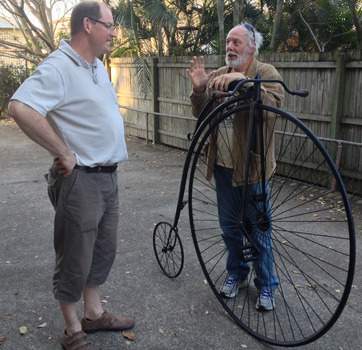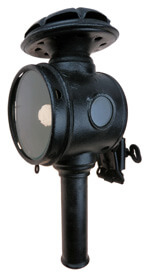
Through the generosity of Mr Bradley Barlow and his wife, Jeni, the Abbey Museum is extremely fortunate to have been donated a penny-farthing bicycle dating to about the late 1870s. The gift also included a rare bicycle bell, a Lucas bicycle lock and a candle lamp.

Penny farthing bicycle candle lamp
Penny-farthings are an extreme type of early bicycle. They were popular, particularly with men, until the advent of the modern safety bicycle in the 1880s. Their production preceded the advent of the cart and allowed the first cheap mechanical locomotion after the French ‘boneshaker’ (basically a frame on wheels propelled by being pushed along with the feet). Although penny-farthings stimulated the sport of cycling, they were dangerous to ride (as Bradley can testify), with numerous accounts of injuries and even death from ‘coming a cropper’ or ‘taking a header’. Riders coasting down hills often took their feet off the pedals and put them over the tops of the handlebars, so they would be pitched off feet-first instead of head-first.

Although commonly referred to as penny-farthings, because of comparison with a large penny and a smaller farthing coin, it is likely that this name only came into usage as penny-farthings began to be replaced by the smaller wheeled safety bicycle and for most of their short reign, aficionados simply called them ‘bicycles’.
Penny-Farthing bicycle – a Cultural Gift
The splendid 1870’s penny farthing bicycle – our first acquisition through the Cultural Gifts Program – was installed between the Victorian display and the Queen’s Gifts and a successful launch held on Saturday 7th June 2014. It was particularly rewarding to have the two donors present to receive our grateful thanks for their generosity. The bicycle continues to be a popular addition with visitors enjoying posing for photographs in front of the display.
Visit the Museum to see this wonderful if somewhat dangerous example of an early bicycle. The Museum is open Monday to Saturday from 10 am to 4 pm.
If you would like to donate an object to the Museum please contact us so we can be sure that it aligns with the Collection Policy.

